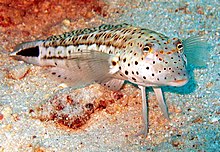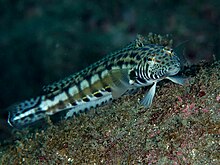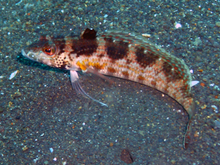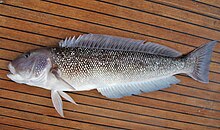Sand perch
| Sand perch | ||||||||||||
|---|---|---|---|---|---|---|---|---|---|---|---|---|

Parapercis colias |
||||||||||||
| Systematics | ||||||||||||
|
||||||||||||
| Scientific name | ||||||||||||
| Pinguipedidae | ||||||||||||
| Günther , 1860 |
The sand perch or crocodile fish (Pinguipedidae) ( Syn .: Parapercidae) are bottom -dwelling predatory fish from the group of perch relatives (Percomorphaceae). Sandfish live in the tropical and subtropical areas of the Atlantic and Indo-Pacific and in the Red Sea . The fish wait on the ground as lurking hunters on their pectoral fins, supported by small fish and crustaceans swimming by.
features
Sandfish have an elongated, cylindrical body. The mouth is pointed, set with sharp teeth, thick-lipped and can be turned forward, the eyes are raised. The dorsal and anal fin are long, the first five rays of the dorsal fin are much shorter than the following. The pelvic fins sit in front of or just below the pectoral fins . The lateral line organ is continuous, sand perch have small ctenoid scales . Sandfish are similar in shape and behavior to the unrelated lizardfish , but they have short dorsal and anal fins. The animals are generally 8 to 30 centimeters long. Prolatilus jugularis reaches a length of 40 centimeters, the two species of the genus Pinguipes are 50 and 70 centimeters long and the two species of the genus Pseudopercis are the largest members of the family with a length of one and 1.20 meters respectively.
Fins formula : dorsal IV – VII / 19–27, anal I – II / 16–24, ventral I / 5, caudal 13–15
Reproduction
Sand perches live in harem associations with one male and several females who own the territory. The sexes usually differ in color. To spawn, they rise from the ground at dusk and release eggs and sperm. The 1.5 to 3 millimeter large larvae initially live pelagic for one to two months . After the metamorphosis , they look for sandy soils near rock and coral reefs . Sandfish are hermaphrodites . All fry are female first. If the male of the harem association dies, the highest-ranking female is transformed into a male.
Systematics
There are over 80 species known in seven genera. All but eight species belong to the genus Parapercis .
-
Kochichthys Kamohara, 1961 .
- Kochichthys flavofasciatus (Kamohara, 1936) .
-
Parapercis Bleeker , 1863 .
- Parapercis albipinna Randall, 2008 .
- Parapercis albiventer Ho et al., 2014 .
- Parapercis alboguttata ( Günther , 1872) .
- Parapercis algrahami Johnson & Wilmer, 2018 .
- Parapercis allporti (Günther, 1876) .
- Parapercis altipinnis Ho & Heden, 2017 .
- Parapercis atlantica ( Vaillant , 1887) .
- Parapercis aurantiaca Döderlein, 1884 .
- Parapercis australis Randall, 2003 .
- Parapercis banoni Randall & Yamakawa, 2006 .
- Parapercis basimaculata Randall, Senou & Yoshino, 2008 .
- Parapercis bicoloripes Prokofiev, 2010 .
- Parapercis bimacula Allen & Erdmann, 2012 .
- Parapercis binivirgata (Waite, 1904) .
- Parapercis binotata Allen & Erdmann, 2017 .
- Parapercis biordinis Allen, 1976 .
- Parapercis caudopellucida Johnson & Motomura, 2017.
- Parapercis cephalopunctata (Seale, 1901) .
- Lattice sand perch ( Parapercis clathrata ) Ogilby , 1910 .
- Parapercis colemani Randall & Francis, 1993 .
- Parapercis colias ( Forster , 1801) .
- Parapercis compressa Randall, 2008 .
- Pointed head sand perch ( Parapercis cylindrica ) ( Bloch , 1792) .
- Parapercis decemfasciata (Franz, 1910) .
- Parapercis diagonalis Randall, 2008 .
- Parapercis diplospilus Gomon, 1981 .
- Parapercis dockinsi McCosker, 1971 .
- Parapercis dongshaensis Chen, Tsai & Hsu, 2013 .
- Parapercis filamentosa ( Steindachner , 1878) .
- Parapercis flavescens Fourmanoir & Rivaton, 1979 .
- Parapercis flavipinna Johnson & Motomura, 2017.
- Parapercis flavolabiata Johnson, 2006 .
- Parapercis flavolineata Randall, 2008 .
- Parapercis fuscolineata Fourmanoir, 1985 .
- Parapercis gilliesii (Hutton, 1879) .
- Slender sand perch ( Parapercis haackei ) (Steindachner, 1884) .
- Tail spot sand perch ( Parapercis hexophtalma ) ( Cuvier , 1829) .
- Parapercis hoi Johnson & Motomura, 2017.
- Parapercis imamurai Johnson & Wilmer, 2018 .
- Parapercis johnsoni Hsuan-Ching Ho, 2015 .
- Parapercis kamoharai Schultz, 1966 .
- Parapercis katoi Randall, Senou & Yoshino, 2008 .
- Parapercis kentingensis Ho, Chang & Shao, 2012 .
- Parapercis lata Randall & McCosker, 2002 .
- Parapercis lineopunctata Randall, 2003 .
- Parapercis lutevittata Liao, Cheng & Shao, 2011 .
- Parapercis macrophthalma (Pietschmann, 1911) .
- Parapercis maculata (Bloch & Schneider , 1801) .
- Parapercis maramara Sparks & Baldwin, 2012 .
- Parapercis maritzi Anderson, 1992 .
- Multi-point sand perch ( Parapercis millepunctata ) (Günther, 1860) .
- Parapercis moki Ho & Johnson, 2013 .
- Parapercis multifasciata Döderlein, 1884 .
- Striped sand perch ( Parapercis multiplicata ) Randall, 1984 .
- Parapercis muronis (Tanaka, 1918) .
- Parapercis natator Randall, Senou & Yoshino, 2008 .
- Parapercis nebulosa ( Quoy & Gaimard , 1825) .
- Parapercis nigrodorsalis Johnson, Struthers & Wilmer, 2014 .
- Parapercis okamurai Kamohara, 1960 .
- Parapercis ommatura Jordan & Snyder, 1902 .
- Parapercis pacifica Imamura & Yoshino, 2007 .
- Parapercis phenax Randall & Yamakawa, 2006 .
- Parapercis pogonoskii Johnson & Wilmer, 2018 .
- Parapercis pulchella ( Temminck & Schlegel , 1843) .
- Parapercis punctata (Cuvier, 1829) .
- Spotted sand perch ( Parapercis punctulata ) (Cuvier, 1829) .
- Parapercis queenslandica Imamura & Yoshino, 2007 .
- Parapercis ramsayi (Steindachner, 1883) .
- Parapercis randalli Ho & Shao, 2010 .
- Parapercis robinsoni Fowler, 1929 .
- Parapercis roseoviridis (Gilbert, 1905) .
- Parapercis rubricaudalis Johnson & Motomura, 2017.
- Parapercis rubromaculata Ho, Chang & Shao, 2012 .
- Parapercis rufa Randall, 2001 .
- Parapercis sagma Allen & Erdmann, 2012 .
- Red-spotted sandfish ( Parapercis schauinslandii ) (Steindachner, 1900) .
- Parapercis sexfasciata (Temminck & Schlegel, 1843) .
- Parapercis sexlorata Johnson, 2006.
- Parapercis shaoi Randall, 2008 .
- Maldives sand perch ( Parapercis signata ) Randall, 1984 .
- Parapercis simulata Schultz, 1968 .
- Snyder's sand perch ( Parapercis snyderi ) Jordan & Starks, 1905 .
- Parapercis soliorta Johnson & Motomura, 2017.
- Parapercis somaliensis Schultz, 1968 .
- Parapercis stricticeps (De Vis, 1884) .
- Parapercis striolata (Weber, 1913) .
- Eye-stripe sand perch ( Parapercis tetracantha ) ( Lacépède , 1801) .
- Parapercis vittafrons Randall, 2008 .
- Parapercis xanthogramma Imamura & Yoshino, 2007 .
- Lips spot sand perch ( Parapercis xanthozona ) (Bleeker, 1849) .
-
Pinguipes Cuvier in Cuvier & Valenciennes , 1829 .
- Pinguipes brasilianus Cuvier, 1829 .
- Pinguipes chilensis Valenciennes, 1833 .
-
Prolatilus Gill, 1865 .
- Prolatilus jugularis (Valenciennes, 1833) .
-
Pseudopercis Miranda Ribeiro, 1903 .
- Pseudopercis numida Miranda Ribeiro, 1903 .
- Pseudopercis semifasciata (Cuvier, 1829) .
-
Ryukyupercis Imamura & Yoshino, 2007 .
- Ryukyupercis gushikeni (Yoshino, 1975) .
-
Simipercis Johnson & Randall, 2006 .
- Simipercis trispinosa Johnson & Randall, 2006 .
swell
- Joseph S. Nelson : Fishes of the World . John Wiley & Sons, 2006, ISBN 0-471-25031-7
- Kurt Fiedler: Textbook of Special Zoology, Volume II, Part 2: Fish . Gustav Fischer Verlag Jena, 1991, ISBN 3-334-00339-6
- Hans A. Baensch / Robert A. Patzner: Mergus Sea Water Atlas Volume 7 Perciformes (perch-like) . Mergus-Verlag, Melle, ISBN 3-88244-107-0
Individual evidence
- ↑ a b c d e Jeffrey W. Johnson and Hiroyuki Motomura. 2017. Five New Species of Parapercis (Perciformes: Pinguipedidae) from southeast Asia and northwest Australia. Zootaxa . 4320 (1); 121-145. DOI: 10.11646 / zootaxa.4320.1.7
- ↑ a b Johnson (2006). Two new species of Parapercis (Perciformes: Pinguipedidae) from north-eastern Australia, and rediscovery of Parapercis colemani Randall & Francis, 1993. Memoirs of Museum Victoria 63 (1): 47-56. PDF
- ^ Johnson & Randall (2006). Simipercis trispinosa, a new genus and species of sandperch (Perciformes: Pinguipedidae) from eastern Australia. Memoirs of Museum Victoria 63 (1): 57-64. PDF
Web links
- Sandfish on Fishbase.org (English)












